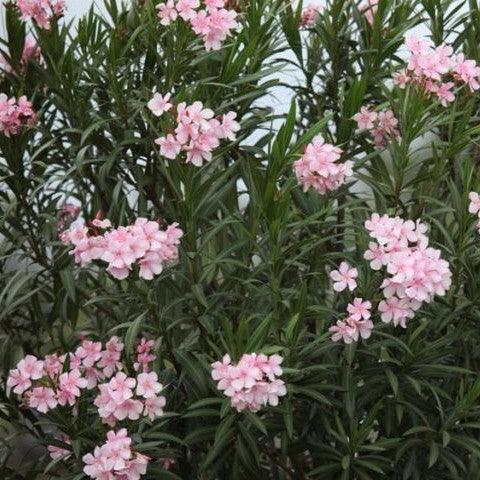-
Plant Description:
-
Nerium oleander 'Roseum' is a cultivar of the common oleander plant. It is a evergreen, or semi-evergreen, shrub or small tree that can grow to be up to 20 feet tall, although it is often smaller when grown in pots. The leaves are dark green and glossy, and the flowers are pink and bloom in clusters.
The plant is very hardy and can tolerate a wide range of growing conditions, including heat, drought, and salt spray. It is also relatively pest- and disease-resistant. It is often used as an ornamental plant, but it is also used for hedging and as a street tree.
Be aware that all parts of the plant are highly toxic if ingested, causing symptoms ranging from vomiting and stomach pains to heart and nervous system issues.
Care of Nerium oleander Roseum: -Plant in well-drained soil in a sunny location. -Water regularly during the first growing season to establish a deep, extensive root system. -Once established, oleander is quite drought tolerant. -If you live in an area with cold winters, oleander should be protected from frost. -Fertilize in spring with a slow-release, balanced fertilizer. -Prune back in late winter or early spring to keep the plant bushy.
It can be propagated by stem cuttings or by seed, but stem cuttings are more reliable.
-
Growing tips:
-
Nerium oleander 'Roseum' is a relatively low-maintenance plant, but it does require some specific care to thrive. Here are some tips for caring for this plant:
-
Light: This plant prefers full sun, but it can also tolerate some light shade.
-
Water: Water the plant regularly during the first growing season to establish a deep, extensive root system. Once established, oleander is quite drought tolerant, but it will benefit from occasional deep watering during extended dry periods.
-
Soil: Plant oleander in well-drained soil. It can tolerate a wide range of soil types, but it prefers a neutral to slightly acidic soil (pH 6.0 to 7.0)
-
Fertilizer: Fertilize in spring with a slow-release, balanced fertilizer. Follow the instructions on the fertilizer package for the correct amount to use.
-
Pruning: Prune back in late winter or early spring to keep the plant bushy and to encourage new growth. When pruning, be sure to wear gloves, as all parts of the plant are toxic if ingested.
-
Temperature: If you live in an area with cold winters, oleander should be protected from frost. It is hardy to USDA zones 8-11.
-
Pest and Disease: It is relatively pest- and disease-resistant. It is also not much affected by air pollution and salt spray.
-
Toxicity: Keep in mind that all parts of the plant are highly toxic if ingested, causing symptoms ranging from vomiting and stomach pains to heart and nervous system issues. Keep it away from pets and children.
By following these care tips, your Nerium oleander 'Roseum' will thrive and provide you with beautiful pink flowers for many years to come.
-
Benefits:
-
Nerium oleander 'Roseum' is a popular ornamental plant that is prized for its beautiful pink flowers and dark green glossy leaves. Some of the benefits of growing this plant include:
-
Long flowering period: The plant produces clusters of pink flowers from spring to fall, which can provide a long period of visual interest in the garden.
-
Low maintenance: Once established, Nerium oleander 'Roseum' is a relatively low-maintenance plant. It is drought-tolerant and can handle a wide range of growing conditions.
-
Versatile: It can be used as a specimen plant, a hedge, or a container plant.
-
Hardiness: It can tolerate a wide range of temperatures and it is relatively pest- and disease-resistant, which makes it a great choice for gardeners of all experience levels.
-
Medicinal Properties: Historically, extracts from the plant have been used in traditional medicine. The plant contain cardiac glycosides, known to have therapeutic effects on heart health and can be used to treat a variety of health conditions. Although it is important to note that consuming or applying any part of the plant may lead to toxicity and must be done under the supervision of a medical professional.
It is important to keep in mind that all parts of the Nerium oleander 'Roseum' plant are highly toxic if ingested, and should be handled and planted with care. It is recommended to plant it in a location where children and pets cannot reach it.



